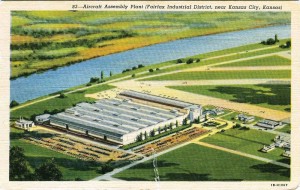By MICHAEL BUSHNELL
Northeast News
May 1, 2013
This 1942 Max Bernstein linen postcard depicts the Aircraft Assembly Plant, Fairfax Industrial District, Kansas City, Kan.
Sent on Feb. 11, 1942, to Mr. Jack Reddan, 3369 Grand Ave., Omaha, Neb., the message reads, “Dear Jack, hope you didn’t forget to mail your value times to Little Rock. I miss your piano practice. Remember, you eat lunch at home Friday. Love, mother.”
First used for aviation purposes in 1921 when the American Legion sponsored a flying show on the grounds, fledgling air-related industries occupied the area around the single dirt runway for eight years prior to its being christened Fairfax Airport in 1928.
Operating as the primary Air Mail departure point in Kansas City through the 1930s, the area was chosen in 1940 as the location of a new light bomber plant when North American Aviation chose an alfalfa field on the northwest corner of the airfield for its new plant.
Through the war years, the plant churned out two-thirds of the Mitchell B-25 medium range, twin engine bombers used in both the Pacific and European theaters of World War II.
Following the war, General Motors took over the operation of the plant, where for the next 41 years, Buicks, Oldsmobiles and Pontiacs rolled off its assembly lines, prompting many locals to dub the plant “B.O.P.” In 1985, General Motors announced plans to build a new, larger facility on the site of the airport, ultimately bringing to a close more than 80 years of aviation history on the Fairfax Airport site.
Hugh Hollinger made the last flight out of the airport on March 31 at 11:59:59 p.m. The wheels of Hollinger’s Cessna lifted off from the runway a few seconds past midnight on April 1, 1985.
The plant shown on this postcard was demolished after GM constructed a new facility almost in the center of the old field, where runways 31 and 22 intersect. The ends of the old runways are used to ferry completed automobiles to waiting railroad cars.


















